Small overlap front: driver-side
Rating applies to 2009-17 models
Tested vehicle: 2012 Volkswagen CC Lux Plus 4-door
The Volkswagen CC was introduced in the 2009 model year. The car is a variant of older (2006-10) models of the Volkswagen Passat sedan with a lower roofline and frameless side windows.
| Evaluation criteria | Rating |
|---|---|
| Structure and safety cage | |
| Driver injury measures | |
| Head/neck | |
| Chest | |
| Hip/thigh | |
| Lower leg/foot | |
|
Driver restraints and dummy kinematics
The dummy’s head barely contacted the frontal airbag before sliding off the left side as the steering column moved 19 cm to the right, leaving the head vulnerable to contact with forward side structure and resulting in little airbag cushioning for the chest. Additionally, the seat belt allowed excessive forward excursion of the dummy’s head and torso. The side curtain airbag did not deploy, leaving the dummy's head vulnerable to contacts with side structure and outside objects. The driver door hinges were torn off and the latch opened, resulting in the door detaching from the vehicle, which shouldn't happen because the driver could be partly or completely ejected from the vehicle. | |
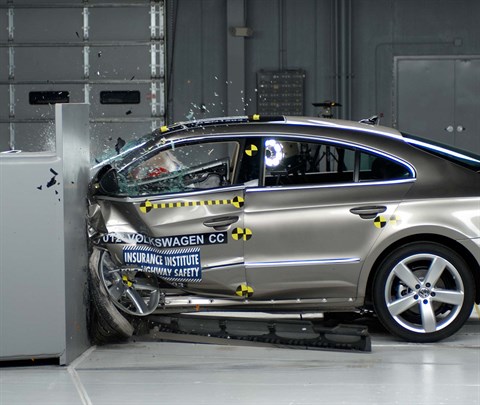
Action shot taken during the small overlap frontal crash test.
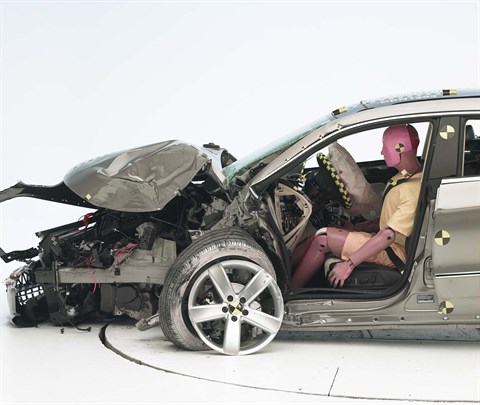
The dummy's position in relation to the door frame, steering wheel, and instrument panel after the crash test indicates that the driver's survival space wasn't maintained well.
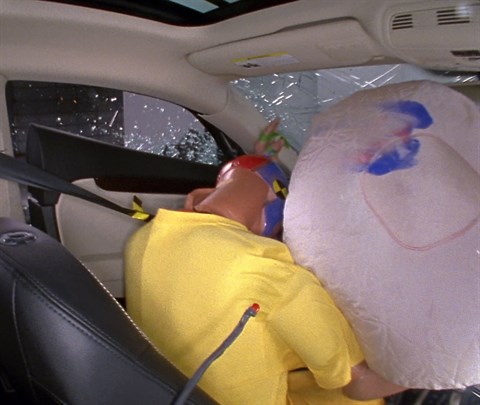
During the crash, the dummy's head and torso barely contacted the airbag before sliding off to the left, and the seat belt allowed the dummy to move too far forward, as is evident from the gap between the seat back and the dummy's torso.
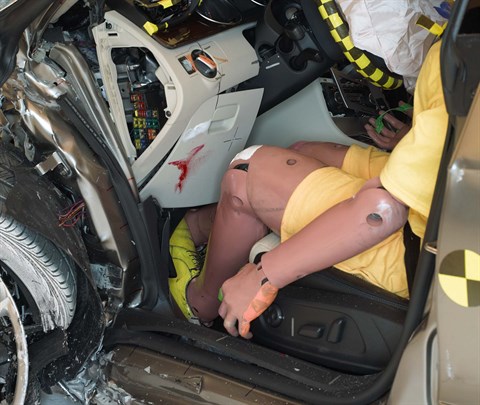
Despite extensive intrusion of the door hinge pillar and instrument panel, risk of injury was moderate and limited to the left thigh.
Measures of occupant compartment intrusion on driver side
| Evaluation criteria | Measurement |
|---|---|
| Test ID | CEN1203 |
| Lower occupant compartment | |
| Lower hinge pillar max (cm) | 24 |
| Footrest (cm) | 13 |
| Left toepan (cm) | 6 |
| Brake pedal (cm) | 3 |
| Parking brake (cm) | 0 |
| Rocker panel lateral average (cm) | 6 |
| Upper occupant compartment | |
| Steering column | 3 |
| Upper hinge pillar max (cm) | 12 |
| Upper dash (cm) | 16 |
| Lower instrument panel (cm) | 17 |
Driver injury measures
| Evaluation criteria | Measurement |
|---|---|
| Test ID | CEN1203 |
| Head | |
| HIC-15 | 131 |
| Peak gs at hard contact | no contact |
| Neck | |
| Tension (kN) | 1.4 |
| Extension bending moment (Nm) | 9 |
| Maximum Nij | 0.26 |
| Chest maximum compression (mm) | 27 |
| Femur (kN) | |
| Left | 6.9 |
| Right | 0.3 |
| Knee displacement (mm) | |
| Left | 4 |
| Right | 1 |
| Knee-thigh-hip injury risk (%) | |
| Left | 10 |
| Right | 0 |
| Maximum tibia index | |
| Left | 0.50 |
| Right | 0.35 |
| Tibia axial force (kN) | |
| Left | 2.6 |
| Right | 1.6 |
| Foot acceleration (g) | |
| Left | 72 |
| Right | 70 |
Moderate overlap front: original test
Rating applies to 2009-17 models
Tested vehicle: 2006 Volkswagen Passat 2.0T 4-door
The Volkswagen CC was introduced in the 2009 model year. The car remains a variant of older (2006-10) models of the Volkswagen Passat sedan with a lower roofline and frameless side windows. Frontal ratings are based on an earlier Institute test of a 2006 model Passat.
| Evaluation criteria | Rating |
|---|---|
| Overall evaluation | |
| Structure and safety cage | |
| Driver injury measures | |
| Head/neck | |
| Chest | |
| Leg/foot, left | |
| Leg/foot, right | |
| Driver restraints and dummy kinematics | |

Action shot taken during the frontal offset crash test of the Volkswagen Passat.
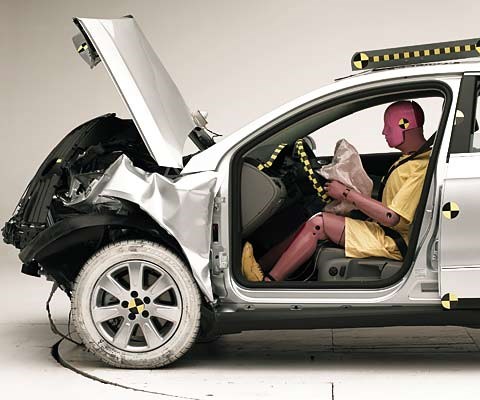
The dummy's position in relation to the steering wheel and instrument panel after the crash test indicates that the driver's survival space was maintained well.
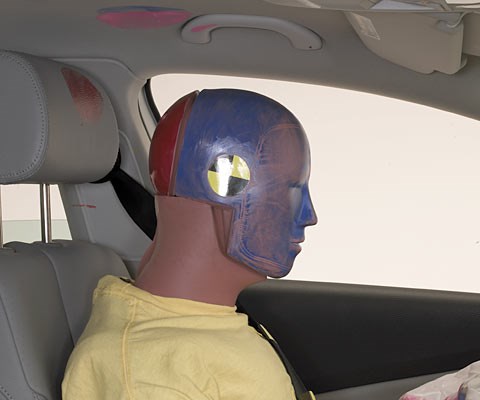
Smeared greasepaint above the dummy's head indicates where the head hit the roof rail and grab handle during rebound. Head accelerations from these hits were low.

Intrusion into the driver's space was minimal, and all leg and foot injury measures were low.
Measures of occupant compartment intrusion on driver side
| Evaluation criteria | Measurement |
|---|---|
| Test ID | CEF0529 |
| Footwell intrusion | |
| Footrest (cm) | 4 |
| Left (cm) | 6 |
| Center (cm) | 6 |
| Right (cm) | 5 |
| Brake pedal (cm) | 6 |
| Instrument panel rearward movement | |
| Left (cm) | 2 |
| Right (cm) | 2 |
| Steering column movement | |
| Upward (cm) | 2 |
| Rearward (cm) | -2 |
| A-pillar rearward movement (cm) | 0 |
Driver injury measures
| Evaluation criteria | Measurement |
|---|---|
| Test ID | CEF0529 |
| Head | |
| HIC-15 | 161 |
| Peak gs at hard contact | 16 |
| Neck | |
| Tension (kN) | 0.8 |
| Extension bending moment (Nm) | 28 |
| Maximum Nij | 0.29 |
| Chest maximum compression (mm) | 26 |
| Legs | |
| Femur force - left (kN) | 0.1 |
| Femur force - right (kN) | 1.8 |
| Knee displacement - left (mm) | 0 |
| Knee displacement - right (mm) | 1 |
| Maximum tibia index - left | 0.33 |
| Maximum tibia index - right | 0.33 |
| Tibia axial force - left (kN) | 1.8 |
| Tibia axial force - right (kN) | 3.0 |
| Foot acceleration (g) | |
| Left | 53 |
| Right | 125 |
Side: original test
Rating applies to 2009-17 models
Tested vehicle: 2009 Volkswagen CC 4-door 4wd with standard front and rear head curtain airbags and standard front seat-mounted torso airbags
The Volkswagen CC was introduced in the 2009 model year. The car remains a variant of older (2006-10) models of the Volkswagen Passat sedan with a lower roofline and frameless side windows. Side ratings are assigned by the Institute based on a test conducted by Volkswagen.
| Evaluation criteria | Rating |
|---|---|
| Overall evaluation | |
| Structure and safety cage | |
| Driver injury measures | |
| Head/neck | |
| Torso | |
| Pelvis/leg | |
| Driver head protection | |
| Rear passenger injury measures | |
| Head/neck | |
| Torso | |
| Pelvis/leg | |
| Rear passenger head protection | |
Measures of occupant compartment intrusion on driver side
| Test ID | VTS0801 |
|---|---|
| B-pillar to longitudinal centerline of driver's seat (cm) | -14.5 |
| Negative numbers indicate the amount by which the crush stopped short of the seat centerline. | |
Driver injury measures
| Evaluation criteria | Measurement |
|---|---|
| Test ID | VTS0801 |
| Head HIC-15 | 143 |
| Neck | |
| Tension (kN) | 0.9 |
| Compression (kN) | 0.4 |
| Shoulder | |
| Lateral deflection (mm) | 24 |
| Lateral force (kN) | 1.1 |
| Torso | |
| Maximum deflection (mm) | 31 |
| Average deflection (mm) | 28 |
| Maximum deflection rate (m/s) | 3.49 |
| Maximum viscous criterion (m/s) | 0.37 |
| Pelvis | |
| Iliac force (kN) | 2.0 |
| Acetabulum force (kN) | 2.3 |
| Combined force (kN) | 4.0 |
| Left femur | |
| L-M force (kN) | 0.9 |
| L-M moment (Nm) | 144 |
| A-P moment (Nm) | 27 |
Passenger injury measures
| Evaluation criteria | Measurement |
|---|---|
| Test ID | VTS0801 |
| Head HIC-15 | 308 |
| Neck | |
| Tension (kN) | 0.2 |
| Compression (kN) | 2.3 |
| Shoulder | |
| Lateral deflection (mm) | 33 |
| Lateral force (kN) | 1.6 |
| Torso | |
| Maximum deflection (mm) | 39 |
| Average deflection (mm) | 31 |
| Maximum deflection rate (m/s) | 3.16 |
| Maximum viscous criterion (m/s) | 0.57 |
| Pelvis | |
| Iliac force (kN) | 0.7 |
| Acetabulum force (kN) | 2.4 |
| Combined force (kN) | 3.0 |
| Left femur | |
| L-M force (kN) | 0.4 |
| L-M moment (Nm) | 19 |
| A-P moment (Nm) | 86 |
Roof strength
Rating applies to 2009-17 models
Tested vehicle: 2011 Volkswagen CC Lux Limited 4-door
Rating does not apply to 4-wheel drive V6 model. Rating of this model is Acceptable.
| Overall evaluation | |
|---|---|
| Curb weight | 3,419 lbs |
| Peak force | 15,057 lbs |
| Strength-to-weight ratio | 4.40 |
Head restraints & seats
Seat type: Power seats
| Overall evaluation | |
|---|---|
| Dynamic rating | |
| Seat/head restraint geometry |
| Seat type | Power seats |
|---|---|
| Geometry | |
| Backset (mm) | 24 |
| Distance below top of head (mm) | -6 |
| Seat design parameters | |
| Pass/fail | Pass |
| Max T1 acceleration (g) | 15.2 |
| Head contact time (ms) | 60 |
| Force rating | 1 |
| Neck forces | |
| Max neck shear force (N) | 11 |
| Max neck tension (N) | 574 |
About the head restraint & seat test
Currently, IIHS tests apply only to front seats.
Headlights
Trim level(s)
- 2.0 Sport trim
- 2.0 R-Line base trim
- 2.0 R-Line Executive trim
- 2.0 R-Line Executive w/ Carbon trim
- 3.6L V6 4Motion Executive trim
| Evaluation criteria | Rating |
|---|---|
| Low-beam headlight type | HID projector |
| High-beam headlight type | HID projector |
| Curve-adaptive? | Yes |
| High-beam assist? | No |
|
Overall rating | |
| Distance at which headlights provide at least 5 lux illumination: | |
Low beams
On the straightaway, visibility was fair on both sides of the road. On curves, visibility was good on both right curves and fair on both left curves.
The low beams never exceeded glare limits.
High beams
On the straightaway, visibility was fair on the right side of the road and inadequate on the left side. On curves, visibility was good on the gradual right curve and fair on the sharp right and both left curves.
| Evaluation criteria | Measurement |
|---|---|
| Trim level(s) |
|
| Low-beam headlight type | HID projector |
| High-beam headlight type | HID projector |
| Curve-adaptive? | Yes |
| High-beam assist? | No |
|
Overall rating Applies to 2016-17 models |
| LOW BEAMS | Average minimum useful illumination distance (5 lux) |
Amount glare exceeded threshold |
|---|---|---|
| Straightaway right edge | 88.7 m | None |
| Straightaway left edge | 54.7 m | None |
| 250m radius right curve, right edge | 73.7 m | None |
| 250m radius left curve, left edge | 55.0 m | None |
| 150m radius right curve, right edge | 63.8 m | None |
| 150m radius left curve, right edge | 53.6 m | None |
| HIGH BEAMS | Average minimum useful illumination distance (5 lux) |
|---|---|
| Straightaway right edge | 136.4 m |
| Straightaway left edge | 98.8 m |
| 250m radius right curve, right edge | 78.5 m |
| 250m radius left curve, left edge | 72.8 m |
| 150m radius right curve, right edge | 64.5 m |
| 150m radius left curve, left edge | 63.5 m |
Front crash prevention: vehicle-to-vehicle
Child seat anchors
Rating applies to 2016-17 models
| Evaluation criteria | Rating |
|---|---|
| Overall evaluation | |
| Vehicle trim | Sport |
| Seat type | leatherette |
This vehicle has 2 rear seating positions with complete child seat attachment (LATCH) hardware.
It has 1 additional seating position with a tether anchor only.
| Evaluation criteria | Rating |
|---|---|
| Overall evaluation | |
| Vehicle trim | Sport |
| Seat type | leatherette |
| Rating icon | Rating |
|---|---|
| G | Good |
| A | Acceptable |
| M | Marginal |
| P | Poor |
| Seating positions that rely on borrowed lower anchors or have only a tether anchor available are not rated. | |
thether anchor symbol | Tether anchor |
lower anchor symbol | Lower anchors |
| Lower anchor(s) can be borrowed from adjacent positions(s) | |
| No hardware available |
Details by seating position
| Position | Rating |
|---|---|
| 1 | |
| Tether anchor | |
| easy-to-find location | |
| no other hardware could be confused for anchor | |
| Lower anchors | |
| too deep in seat | |
| too much force needed to attach | |
| easy to maneuver around anchors | |
| 2 | |
| Tether anchor | |
| easy-to-find location | |
| no other hardware could be confused for anchor | |
| Lower anchors | |
| none available | |
| 3 | |
| Tether anchor | |
| easy-to-find location | |
| no other hardware could be confused for anchor | |
| Lower anchors | |
| too deep in seat | |
| too much force needed to attach | |
| easy to maneuver around anchors |
Seat position 21
| Lower anchor A | |
|---|---|
| Open access rated | No |
| Depth (cm) | 2-4 |
| Force (lbs) | 52 |
| Clearance angle (degrees) | 73 |
| Lower anchor B | |
| Open access rated | No |
| Depth (cm) | 2-4 |
| Force (lbs) | 43 |
| Clearance angle (degrees) | 91 |
| Tether anchor | |
| Location | Rear deck |
| Confusing hardware present | No |
| Has contrasting label within 3 inches of tether anchor |
No |
| Tether anchors can be accessed while seatback is properly positioned for use of LATCH |
Not measured |
Seat position 22
| Lower anchor A | |
|---|---|
| No lower latch for this seat position | |
| Lower anchor B | |
| No lower latch for this seat position | |
| Tether anchor | |
| Location | Rear deck |
| Confusing hardware present | No |
| Has contrasting label within 3 inches of tether anchor |
No |
| Tether anchors can be accessed while seatback is properly positioned for use of LATCH |
Not measured |
Seat position 23
| Lower anchor A | |
|---|---|
| Open access rated | No |
| Depth (cm) | 0-2 |
| Force (lbs) | 43 |
| Clearance angle (degrees) | 86 |
| Lower anchor B | |
| Open access rated | No |
| Depth (cm) | 2-4 |
| Force (lbs) | 51 |
| Clearance angle (degrees) | 57 |
| Tether anchor | |
| Location | Rear deck |
| Confusing hardware present | No |
| Has contrasting label within 3 inches of tether anchor |
No |
| Tether anchors can be accessed while seatback is properly positioned for use of LATCH |
Not measured |
